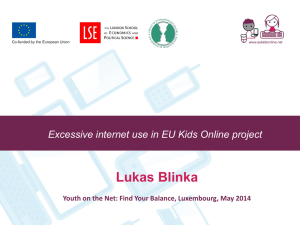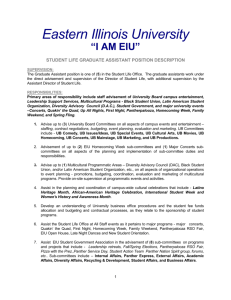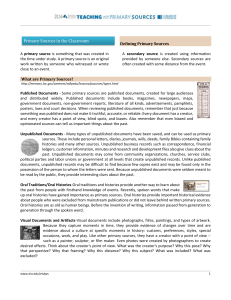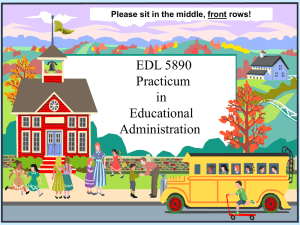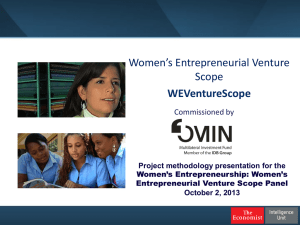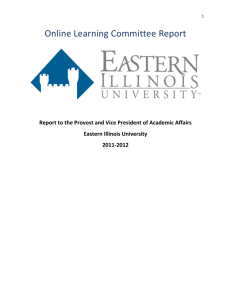2014 Activity Design Packet
advertisement
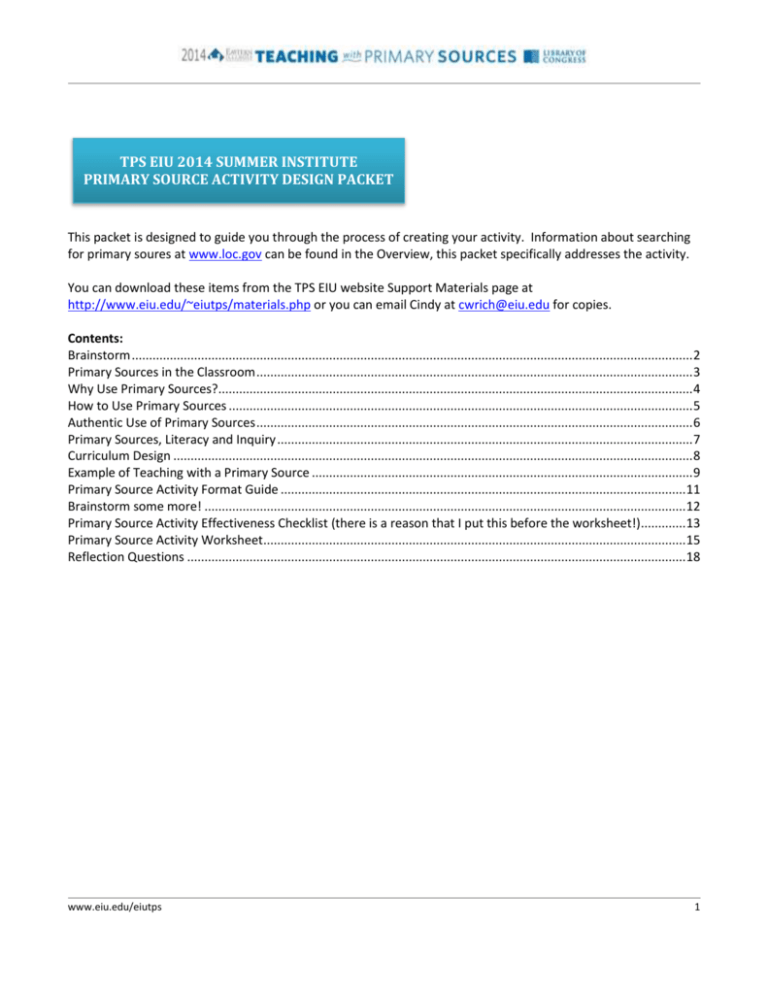
TPS EIU 2014 SUMMER INSTITUTE PRIMARY SOURCE ACTIVITY DESIGN PACKET This packet is designed to guide you through the process of creating your activity. Information about searching for primary soures at www.loc.gov can be found in the Overview, this packet specifically addresses the activity. You can download these items from the TPS EIU website Support Materials page at http://www.eiu.edu/~eiutps/materials.php or you can email Cindy at cwrich@eiu.edu for copies. Contents: Brainstorm .................................................................................................................................................................. 2 Primary Sources in the Classroom .............................................................................................................................. 3 Why Use Primary Sources?......................................................................................................................................... 4 How to Use Primary Sources ...................................................................................................................................... 5 Authentic Use of Primary Sources .............................................................................................................................. 6 Primary Sources, Literacy and Inquiry ........................................................................................................................ 7 Curriculum Design ...................................................................................................................................................... 8 Example of Teaching with a Primary Source .............................................................................................................. 9 Primary Source Activity Format Guide ..................................................................................................................... 11 Brainstorm some more! ........................................................................................................................................... 12 Primary Source Activity Effectiveness Checklist (there is a reason that I put this before the worksheet!)............. 13 Primary Source Activity Worksheet.......................................................................................................................... 15 Reflection Questions ................................................................................................................................................ 18 www.eiu.edu/eiutps 1 What are some topics you will be teaching? Primary Sources are most powerful when they are used in authentic learning situations, opposed to a “special project” that may not connect to curriculum. Let’s look at what you plan to teach and how a primary source can engage learners, promote inquiry and help you assess student understanding. Brainstorm! Topic #1 Topic #2 Topic #3 Possible Primary Sources! Possible Primary Sources! Possible Primary Sources! How I can use them! How I can use them! How I can use them! www.eiu.edu/eiutps 2 Primary Sources in the Classroom A primary source is something that was created in the time under study. A primary source is an original work written by someone who witnessed or wrote close to an event. Defining Primary Sources A secondary source is created using information provided by someone else. Secondary sources are often created with some distance from the event. What are Primary Sources? http://memory.loc.gov/ammem/ndlpedu/lessons/psources/types.html Published Documents - Some primary sources are published documents, created for large audiences and distributed widely. Published documents include books, magazines, newspapers, maps, government documents, non-government reports, literature of all kinds, advertisements, pamphlets, posters, laws and court decisions. When reviewing published documents, remember that just because something was published does not make it truthful, accurate, or reliable. Every document has a creator, and every creator has a point of view, blind spots, and biases. Also remember that even biased and opinionated sources can tell us important things about the past. Unpublished Documents - Many types of unpublished documents have been saved, and can be used as primary sources. These include personal letters, diaries, journals, wills, deeds, family Bibles containing family histories and many other sources. Unpublished business records such as correspondence, financial ledgers, customer information, minutes and research and development files also give clues about the past. Unpublished documents may come from community organizations, churches, service clubs, political parties and labor unions or government at all levels that create unpublished records. Unlike published documents, unpublished records may be difficult to find because few copies exist and may be found only in the possession of the person to whom the letters were sent. Because unpublished documents were seldom meant to be read by the public, they provide interesting clues about the past. Oral Traditions/Oral Histories-Oral traditions and histories provide another way to learn about the past from people with firsthand knowledge of events. Recently, spoken words that make up oral histories have gained importance as primary sources. Oral histories provide important historical evidence about people who were excluded from mainstream publications or did not leave behind written primary sources. Oral histories are as old as human beings. Before the invention of writing, information passed from generation to generation through the spoken word. Visual Documents and Artifacts-Visual documents include photographs, films, paintings, and types of artwork. Because they capture moments in time, they provide evidence of changes over time and are evidence about a culture at specific moments in history: customs, preferences, styles, special occasions, work, and play. Like other primary sources, they have a creator with a point of view -such as a painter, sculptor, or film maker. Even photos were created by photographers to create desired effects. Think about the creator's point of view. What was the creator's purpose? Why this pose? Why that perspective? Why that framing? Why this distance? Why this subject? What was included? What was excluded? www.eiu.edu/eiutps 3 Why Use Primary Sources Why Use Primary Sources (red) handout from http://memory.loc.gov/learn/educators/handouts/index.html Primary sources provide a window into the past—unfiltered access to the record of artistic, social, scientific and political thought and achievement during the specific period under study, produced by people who lived during that period. Bringing young people into close contact with these unique, often profoundly personal, documents and objects can give them a very real sense of what it was like to be alive during a long-past era. 1. 2. 3. Engage students a. Primary sources help students relate in a personal way to events of the past and promote a deeper understanding of history as a series of human events. b. Because primary sources are snippets of history, they encourage students to seek additional evidence through research. c. First-person accounts of events helps make them more real, fostering active reading and response. Develop critical thinking skills a. Many state standards support teaching with primary sources, which require students to be both critical and analytical as they read and examine documents and objects. b. Primary sources are often incomplete and have little context. Students must use prior knowledge and work with multiple primary sources to find patterns. c. In analyzing primary sources, students move from concrete observations and facts to questioning and making inferences about the materials. d. Questions of creator bias, purpose, and point of view may challenge students’ assumptions. Construct knowledge a. Inquiry into primary sources encourages students to wrestle with contradictions and compare multiple sources that represent differing points of view, confronting the complexity of the past. b. Students construct knowledge as they form reasoned conclusions, base their conclusions on evidence, and connect primary sources to the context in which they were created, synthesizing information from multiple sources. c. Integrating what they glean from comparing primary sources with what they already know, and what they learn from research, allows students to construct content knowledge and deepen understanding. www.eiu.edu/eiutps 4 How to Use Primary Sources How to Use Primary Sources (green) handout from http://memory.loc.gov/learn/educators/handouts/index.html A Quick Start Guide Primary sources are the raw materials of history — original documents and objects which were created at the time under study. They are different from secondary sources, accounts or interpretations of events created by someone without firsthand experience. Examining primary sources gives students a powerful sense of history and the complexity of the past. Helping students analyze primary sources can also guide them toward higher-order thinking and better critical thinking and analysis skills. Before you begin: • Choose two or three primary sources that support the learning objectives and are accessible to students. • Consider how students can compare these items to other primary and secondary sources. • Identify an analysis tool or guiding questions that students will use to analyze the primary sources 1. Engage students with primary sources. Draw on students’ prior knowledge of the topic. • Ask students to closely observe each primary source. • Who created this primary source? • When was it created? • Where does your eye go first? • Help students see key details. • What do you see that you didn’t expect? • What powerful words and ideas are expressed? • Encourage students to think about their personal response to the source. • What feelings and thoughts does the primary source trigger in you? • What questions does it raise? 2. Promote student inquiry. • Encourage students to speculate about each source, its creator, and its context. • What was happening during this time period? • What was the creator’s purpose in making this primary source? • What does the creator do to get his or her point across? • What was this primary source’s audience? • What biases or stereotypes do you see? • Ask if this source agrees with other primary sources, or with what the students already know. • Ask students to test their assumptions about the past. • Ask students to find other primary or secondary sources that offer support or contradiction. 3. Assess how students apply critical thinking and analysis skills to primary sources. • Have students summarize what they’ve learned. • Ask for reasons and specific evidence to support their conclusions. • Help students identify questions for further investigation, and develop strategies for how they might answer them. • Analysis tools and thematic primary source sets from the Library offer entry points to many topic www.eiu.edu/eiutps 5 Authentic Use of a Primary Source Effective Teachers: 1. Prepare students to work with sources Preparation/ Question Phase Choose a “good source” E.g. one that: Supports a clear aim Is accessible to students Offers a mystery or puzzle Give students a method for analyzing primary sources Create an analysis guide tailored to the specific type of primary source Model or review the method with students prior to lesson Elicit students’ prior knowledge about the topic What do students already know or believe to be true? What do they want to know? What questions do they have? www.eiu.edu/eiutps Library of Congress definition: Using a primary source within an historical context as a basis for inquiry and discovery. 2. Use primary sources well at any of three phases of a lesson or unit Intro/Investigation Phase Primary Sources engage students and help them “greet” the topic Inquiry/Check Phase Primary Sources provide rich data for student investigations Presentation/Share Phase Primary Sources provide evidence for students’ conclusions Effective teachers … Pose questions to elicit active student response Where does your eye go first? How does this make you feel? What questions about the topic does this raise for us? Effective teachers … Target subject-specific ideas & skills (in history, math, art, English, etc.) Effective teachers … Clarify the purpose of the report or presentation Persuasive Narrative, informational Advocacy or argument Develop fundamental visual & print literacy skills Close observation, decoding, vocabulary, e.g.: Write down everything you see Underline powerful words Circle key details Identify difficult words/ phrases, create glossary, etc. Work with multiple sources, looking for patterns Does this source agree with the others? With what you already know? Can you group the sources according to similarities? How would you summarize what the patterns tell us? Comprehension, e.g.: Strategies for summarizing Deciding what is important and what is not Identifying what the author wanted to convey Writing a personal response Develop critical thinking What biases or stereotypes do you see? Is this fair/balanced? How might it look if the author had different experiences? E.g. help students: Put sources in context Who made this? When? For what audience? For what purpose? Teach students how to use a source as evidence What specific parts support what you’re saying? Which don’t? How do you know? Probe for understanding Ask for reasons & evidence, e.g., “Why do you say that? Where in the doc. do you see that?” Be alert to student misconceptions & correct them. Help students summarize what they’ve learned from all the sources, and what questions remain. 6 Primary Sources, Inquiry & Literacy Teaching and Learning Strategies Connect Facilitate conversation Small group discussion Learning logs / Charting Webbing Pre-reading aids Engagement and exploration Wonder Class brainstorming Peer questioning Question stems Anticipation Guide Investigate Find information Two column note taking Notes/Reflection Main Idea/Details, Examples Guided Practice Ideas from Text/ Connections to Prior Knowledge Organize sources Evaluate information Literacy (read media – maps, images, documents, etc.) Pre-Reading & Sharing Relate topic to own life, real world Activate prior knowledge Understand context, specialized vocabulary, purpose of text Recognize central them or big idea Connect personally to topic (human face of history) Context, background knowledge Find central theme/, big idea Identify pre-existing mental models Interpret individually Pre-Reading Generate original questions Develop questions to push comprehension Pursue deep questions over superficial Predict what text will say During Reading Use text to extract meaning & frame ideas Boost comprehension (skim, find main idea, paraphrase, organizer, summarize, generate questions, determine author point of view) Deepen thinking while writing (identify key ideas & supporting evidence, generate questions, organize, clarify point of view) Check comprehension while reading, clarity and coherence while writing. Construct Charting/ Mindmapping Post-Reading Composing Interpret the meaning of the text (finding Questioning: teacher-to-student, patters and relationships, comparing to prior knowledge, making inferences) student-to-teacher, student-tostudent Draw Conclusions and develop new understandings Express Use rubric with specific criteria Post-Reading Select format based on topic and Share new understandings with others through discussion, writing, presentation audience Identify sources Reflect Feedback from teacher & peers Post-Reading Reflect on new ideas and new questions Reflection Log: I Used to that have emerged Think/Now I Know Reflect on own progress in reading and writing www.eiu.edu/eiutps Inquiry + Literacy In A Digital Environment Establish authority of sources Corroborate information Connect meaning across sources Interpret visual/audio as well as text Read for deep meaning rather than superficial collection of facts Actively seek multiple perspectives Organize & Interact with text Resist “graphic seduction” and “presentationism” Synthesize bits of information Use interactive tools to collaborate Employ critical thinking strategies to strengthen quick action, quick decision Resist copy-and-paste Communicate through multiple media Use social writing and presenting tools Present to authentic audiences Overcome “all about me” by building reflection into blogs and social networking Create contemplative environment 7 Curriculum Design Motivation for Creating Learning Experiences Incorporating a Primary Source. Content: Library of Congress primary sources provide the impetus for learning and are directly related to curriculum standards. Primary sources are essential to the learning experience and used to add dimension, depth, and different levels of challenge or interest to the topic under study. Occasionally… An educator comes across a primary source that is exceptional and they build a classroom event around that item and the teachable moment. Process: The learning process is centered on a question based on curriculum standards connected to an explicit understanding goal. Effective Practices provide a means for students to develop understanding, knowledge, and skills. Products: The student response to a question reveals progress toward learning goals including: understanding, knowledge, and skills. Underwood. (1905). Baby’s introduction to the chicks. Library of Congress, Prints and Photographs Division Activity Types Defined by Primary Source Purposes Introductions use the primary source(s) to invite students to greet the topic under study. Students interact with primary sources much like visitors interact with items in a museum exhibition. An Introduction is like meeting someone for the first time. We take a moment to learn about each other and find out what we have in common. Introductions spark interest, identify learning goals, and help develop connections with experiences and prior knowledge Introduction: Build Relationship with the topic under study using primary sources to: 1. spark interest and curiosity. 2. connect topic to personal experiences. 3. recognize prior subject area knowledge to topic. 4. identify questions the primary sources inspire about the topic. Investigations challenge students to be researchers and examine primary sources to learn about a topic. Investigation: Make Sense of the primary sources to learn about the topic under study: 1. read: comprehend the message of the primary source by using word attack and vocabulary skills, comprehension strategies, and media literacy skills. (Read could be listen for an audio recording or view for an image). 2. analyze: consider the purpose of the primary source, context, and point of view. 3. interpret: stretch thinking about the topic under study by checking to see how this information, confirms, challenges, or changes our previous thinking on the topic. 4. question: identify questions for future research based on this investigation. Formal Assessments use primary sources as evidence to support thinking. Students reveal thoughts on a topic and use primary sources to support their hypothesis about the topic. Formal Assessment: Recognize Growth and Use Learning Productively 1. reflect on learning from Introduction and Investigation, recognize how individual thinking has been confirmed, challenged, and sometimes changed. 2. determine a useful product or performance to show thinking to others. 3. use thinking, knowledge, and skills to create the product or performance. 4. consider how well the product or performance makes thinking, knowledge, and skills visible. 5. revise product or performance to increase the thinking, knowledge, and skills shown www.eiu.edu/eiutps 8 These pages offer a look at one way that a primary source can be used in the classroom. YOU know what the students in your classroom need. Customize an analysis sheet or questions to encourage discussion of a specific topic or guide learning. Remember, there are several analysis sheets on the TPS EIU site that you can use for inspiration or create your own from scratch! Example of Teaching with a Primary Source Analyzing a Primary Source Topic of Study Title of Source: Author: Genre (cartoon, letter, photo?) WHO Author: background, sex, race, social class, education, WHEN & WHERE Place and Time: When and Where was it published? credibility, expertise, perspective? Historical Context: What was going on during this event or Audience: Who is the intended audience? OBSERVATIONS Description of Source Meaning What I see… Evidence of… What the objects, words, etc. mean www.eiu.edu/eiutps era/period? Questions Message/Argument The author is trying to tell me… I wonder… My reaction to the source is… 9 IDENTIFYING THE MAIN IDEA Looking at your observations of the primary source, what is the main idea or message of the source? APPLYING THE SOURCE I think I can use this source in my essay because… WRITING USING THE PRIMARY SOURCE Focus Question: tells us that (title of source or author) (author or subject) thought (the primary source’s message, what it is trying to tell me) because (evidence in the primary source) This primary source relates to the focus question because www.eiu.edu/eiutps 10 Primary Source Activity Format for Dissemination This is the format that your activity will follow. These items are required. Final version due before Friday, July 31, 2014 A. Title B. Overview C. Essential Question D. Learning Objectives 1. Objective One 2. Objective Two 3. Objective THree E. Time Required F. Grade Range G. Discipline/Subject H. Topic (American Memory) I. Era J. Common Core State Standards K. Materials Used 1. Support Materials 2. Library of Congress Primary Sources Used 3. Other electronic resources L. Procedure 1. List every step and all resources used i. Document as if they are detailed plans for a sub! M. Activity Assessment N. Extension O. Author Credits P. Appendices 1. all materials and handouts 2. print versions of primary sources 3. etc. www.eiu.edu/eiutps 11 Brainstorm more! Events associated with my topic People associated with my topic Objects associated with my topic Topic Places associated with my topic Other things to consider… www.eiu.edu/eiutps 12 Are you getting the most bang for your buck with the primary source that you chose? Don’t just use it for decoration – it is a powerful teaching tool!! TPS lessons engage students, promote critical thinking, and build content knowledge. Use these guidelines to review lessons and check for key components. Primary Source Activity Effectiveness Checklist I. Does the activity include all of the following approaches: Supports inquiry by posting questions that are relevant to learning goals A and require analysis of primary sources. Models primary source analysis that includes observing, reflecting and B questioning. C Uses primary sources that connect to the subject/topic under study. D Presents primary sources in a historically accurate context. E F Provides for students of varying abilities, learning styles and interests to learn with primary sources. Requires students to demonstrate knowledge or skills gained from the analysis of primary sources. II. Include one or more of these student activities: Beginners and students in lower grades Comments: Yes No Yes No Yes No Yes No Yes No Yes No Comments: Identify details when observing a primary source Connect primary sources to self, family and/or community Ask questions related to observations and the topic of a primary source Speculate about who created a primary source, when and for what purpose Place a primary source(s) in a timeline Consider whether observations contradict or support what they know Identify point of view with primary sources Categorize primary sources to show relationships between them Make comparisons with primary sources Consider issues of cause and effect, context and/or continuity and change Articulate ideas of beliefs formed by observing primary sources Express learning in a variety of ways using primary sources Reflect on their learning Connect new knowledge from primary sources to other learning experiences www.eiu.edu/eiutps 13 Experienced students and those in higher grades Analyze primary sources to formulate questions that connect to the topic of study Identify who created the primary source, when and for what purpose Use previous knowledge to place primary sources into historical context Examine primary sources closely to form conjectures about their meaning and intent Investigate issues of cause and effect, causality, context and continuity and change Corroborate information using additional primary and/or secondary sources to form and test hypotheses Comments: Draw conclusions about questions and hypotheses Formulate investigative questions Select primary sources to support their own investigations Reflect on their learning process to consider expansion, extension or modification Seek feedback from peers III. Check that the following elements are included: Element Description and comments Library of Learning with Library of Congress primary sources is central to the lesson Congress Primary Lesson includes appropriate citations and copyright information. Sources Learning Standards Yes No Yes No Lesson aligns to an identified set of content curricular standards Yes No Learning goals align to curricular standards Yes No The content of the lesson supports the learning goals Yes No Lesson Structure Procedures are clear and replicable and Alignment Lesson provides explicit instructions for analyzing primary sources Student assessment aligns to learning goals www.eiu.edu/eiutps Acceptable Yes No Yes No Yes No 14 Primary Source Activity Worksheet Use this worksheet to create a draft of your activity. You can download it from the TPS EIU site and type right in the boxes. (They will grow with your text.) A. Title. B. Overview Who, what, how and why in 2 or 3 sentences C. Essential Question What big idea(s) do you want students to explore through this activity? D. Learning Objectives statements describing learner outcomes in measurable & obtainable terms. After completing this activity students will be able to: 1. 2. 3. E. Time Required ______ class periods of ______ minutes F. Grade Range 3-5 G. Discipline/Subject 6-8 9-12 H. Topic – Circle those that apply from American Memory homepage at http://memory.loc.gov/ammem/index.html Advertising African American History Architecture, Landscape Cities, Towns Culture, Folklife Environment, Conservation Literature Maps Religion Sports, Recreation Government, Law Native American History War, Military Immigration, American Expansion Performing Arts, Music Presidents Technology, Industry Women’s History I. Era – Circle those that apply www.loc.gov/teachers/classroommaterials/presentationsandactivities/presentations/timeline/ Settlement, Beginning to 1763 National Expansion and Reform, 1815-1860 Progressive Era to New Era, 1900-1929 The American Revolution, 1763-1783 The New Nation, 1783-1815 Civil War and Reconstruction 1861-1877 Rise of Industrial America, 1876-1900 Great Depression/World War II, 1929-1945 Postwar United States, 1945-1968 J. Standards Common Core standards that you feel are applied or addressed in this activity www.eiu.edu/eiutps 15 K. Materials Used ALL materials needed to conduct the lesson and are referenced in the “Procedures.” Obey copyright laws. All materials used must be included within or attached to when submitted. Handouts or instruction sheets: Analysis Tools: Rubrics: Presentation tools: Other: Library of Congress Primary Sources Image thumbnail Title: Creator & Date of Creation: URL : Notes: Image thumbnail Title: Creator & Date of Creation: URL : Notes: Other Image thumbnail Title: Creator & Date of Creation: URL : Notes: www.eiu.edu/eiutps 16 L. Description of Procedure a numbered list of teacher actions needed to implement this lesson. The description gives specific, clear and concise instructions and lists all materials used and referenced. It is better to provide too much and remove extra later. Procedure Step # Resource/Material Used 1. 2. 3. 4. 5. 6. 7. 8. 9. 10. 11. 12. Notes: M. Activity Assessment N. Extension Ideas O. Author Credits Name: School: www.eiu.edu/eiutps 17 Primary Source Activity Reflection This must be completed AFTER the primary source activity has been implemented. Answer all parts of all questions. Completed reflection should be between 2 – 4 pages in length. If multiple activities are created, a separate reflection document is required for each activity. 1. Teacher and School Name: 2. Activity Title: 3. Library of Congress primary source(s) used: #1-3 are found on the bibliographic page of the primary source, the description is your own words (1) Complete Title: (2) Author, Creator: (3) Found in LOC Collection/Division: (4) Description: 4. Grade Level and Class: 5. Topic/Theme/Unit Being Studied: 6. Date Implemented: 7. Analysis of Student Engagement and Learning: a. Did the primary source support teaching by engaging students? Please provide examples that you observed to support your opinion. b. Do you feel that this activity supported your teaching goals for this topic? Explain. c. Do you think students enjoyed the activity? Why or why not? 8. Activity Analysis a. What do you feel was the strength or best piece of this activity and why? b. Identify two things that you would change or add to this activity? What brought you to this decision? 9. How do you feel that your activity supports the implementation of any of the Common Core State Standards? Please provide an example. 10. Optional: Any other comments or ideas you want to share. www.eiu.edu/eiutps 18

